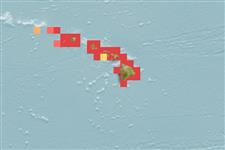>
Mulliformes (Goatfishes) >
Mullidae (Goatfishes)
Etymology: Parupeneus: Latin, parum, parvum = small + Peneus, the name of a river.
Issue
FishBase common name coined in Uiblein et al. (2024: Ref. 130857). Whitesaddle goatfish was previously used for Parupeneus ciliatus.
Environment: milieu / climate zone / Mức độ sâu / distribution range
Sinh thái học
Biển Cùng sống ở rạn san hô; Mức độ sâu 1 - 140 m (Ref. 9710). Tropical; 24°N - 18°N, 164°W - 153°W
Eastern Central Pacific: Hawaii.
Length at first maturity / Bộ gần gũi / Khối lượng (Trọng lượng) / Age
Chín muồi sinh dục: Lm ?, range 26 - ? cm
Max length : 51.0 cm TL con đực/không giới tính; (Ref. 54393)
Các tia vây lưng cứng (tổng cộng) : 8; Các vây lưng mềm (tổng cộng) : 9; Tia mềm vây hậu môn: 7; Động vật có xương sống: 24. Diagnosis: Pectoral rays 15 (rarely 14 or 16). Gill rakers 6-7 + 24-27 (total 30-34). Body depth 2.85-3.25 in SL; head length (HL) 2.85-3.1 in SL; snout length 1.85-2.2 in HL; barbels short, 1.65-1.95 in HL; longest dorsal spine 1.55-1.85 in HL; last dorsal ray slightly longer than penultimate ray; posterior margin of each caudal lobe convex; pectoral-fin length 1.3-1.5 in HL; pelvic-fin length 1.2-1.4 in HL. Body red to reddish brown dorsally, light red ventrally, with a white saddle-like spot on caudal peduncle flanked anteriorly and posteriorly by a dusky spot, the posterior one darkest; a reddish brown band from front of snout through eye and along body to above lateral line, fading and broadening below second dorsal fin, dark band behind eye and anteriorly on body bordered by a white band; fins mainly red; barbels white (Ref. 54393).
Body shape (shape guide): fusiform / normal.
Inhabits lagoon and seaward reefs; in small groups under ledges or among corals by day, dispersing at night to feed among rocks and corals on benthic crustaceans (Ref. 9710). It is a nocturnal predator that feeds mostly on benthic crustaceans (Ref. 13550). Spawning appears to be year-round with the peak from December to July; females may spawn more than once a year (Ref. 54393).
Randall, J.E., 2004. Revision of the goatfish genus Parupeneus (Perciformes: Mullidae), with descriptions of two new species. Indo-Pac. Fish. (36):64 p. (Ref. 54393)
IUCN Red List Status (Ref. 130435: Version 2025-1)
Threat to humans
Harmless
Human uses
Các nghề cá: Tính thương mại
Các công cụ
Special reports
Download XML
Các nguồn internet
Estimates based on models
Preferred temperature (Tài liệu tham khảo
123201): 8.9 - 25.5, mean 20.3 °C (based on 8 cells).
Phylogenetic diversity index (Tài liệu tham khảo
82804): PD
50 = 0.5000 [Uniqueness, from 0.5 = low to 2.0 = high].
Bayesian length-weight: a=0.02239 (0.01117 - 0.04486), b=3.19 (3.02 - 3.36), in cm total length, based on LWR estimates for this species & Genus-body shape (Ref.
93245).
Mức dinh dưỡng (Tài liệu tham khảo
69278): 4.0 ±0.60 se; based on food items.
Generation time: 2.0 ( na - na) years. Estimated as median ln(3)/K based on 1
growth studies.
Thích nghi nhanh (Tài liệu tham khảo
120179): Trung bình, thời gian nhân đôi của chủng quần tối thiểu là 1.4 - 4.4 năm (K=0.5; tm=1).
Fishing Vulnerability (Ref.
59153): Low to moderate vulnerability (27 of 100).
🛈
Nutrients (Ref.
124155): Calcium = 27.7 [13.3, 62.8] mg/100g; Iron = 0.303 [0.148, 0.682] mg/100g; Protein = 18.2 [14.9, 21.2] %; Omega3 = 0.139 [0.076, 0.264] g/100g; Selenium = 71.5 [33.1, 172.0] μg/100g; VitaminA = 137 [27, 604] μg/100g; Zinc = 0.409 [0.241, 0.803] mg/100g (wet weight);
